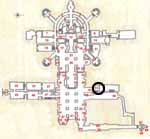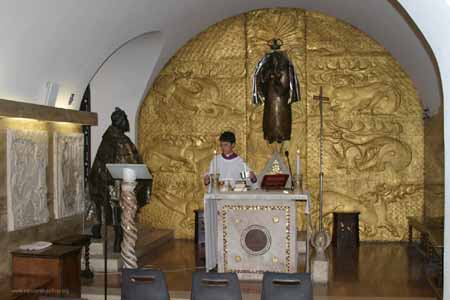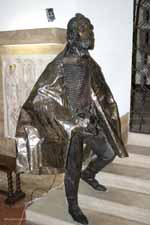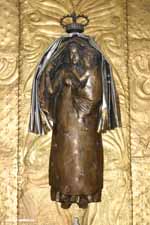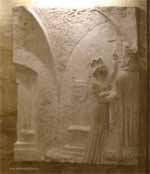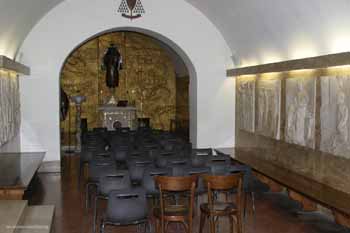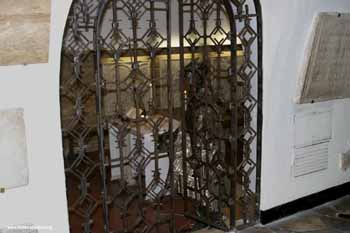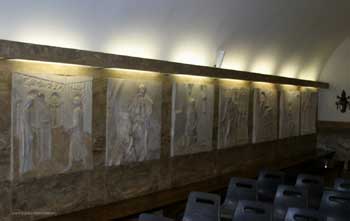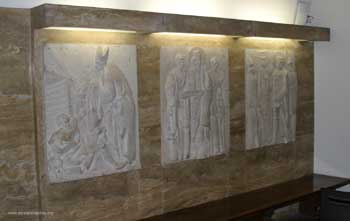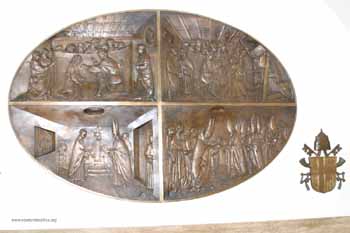| Grottoes
Vatican City Colonnade Saints Floorplan #2 |
| Altars
Monuments The History |
|
Related Links |
|
On the north side of the Vatican Grottoes and to the left side of the Gallery of Clement VIII, is the entrance to the Chapel of Our Lady the Great Queen of Hungary. It's story started in 1977, when Hungarian priests living in Austria and in Germany, led by Mons. Stephen Laszlo, the Bishop of Eisenstadt in Austria, presented to Pope Paul VI the request, on behalf of their Catholic nationals, to build in the grottoes a chapel dedicated to the Madonna "Magna Mater Hungarorum." After the relative research done by the Fabbrica di San Pietro, the pope assigned a vast room to Cardinal Laszlo Lekai, the Archbishop of Esztergom, to realize the project. |
|
|
|
|
|
|
|
|
|
|
|
The barrel-vaulted chapel is located exactly behind the shrine with the tomb of Paul VI and was created from Rooms VIII and IX of the grottoes and the gallery of Clement VIII as the atrium. On October 8, 1980, Pope John Paul II inaugurated the chapel with the celebration of Mass. Present at the event was Cardinal Laszlo Lekai; some 20 Hungarian bishops; Mr. Janos Szita, the Hungarian Ambassador to the Quirinal; Mr Imre Miklos, the Hungarian Secretary of State for Ecclesiastical Affairs; some 100 priests and 500 Hungarian pilgrims, who came to Rome for the occasion. To lateral entrances leas into the chapel. They are decorated with artistic iron gates made by the sculptor Josef Kovacs and placed in the chapel in 1982. The floor is paved with slabs of red Hungarian marble separated with thin brass listels. The back wall of the chapel is entirely covered by 3 stainless steel gilded panels with the embossed figures of legendary deer from the Hungarian tradition. The central panel represents the tree of life with the statue of the Madonna "Magna Domina Hungarorum" with Child. By the first gate is a life-size statue of St Stephen, the first king of Hungary represented in the act of descending the stairs and walking toward the Madonna to the Celestial Lady to present his crown and his entire people. The bronze
patined statues dressed in silver plated drapes are by the Hungarian
sculptor Imre Varga. The cloak of St Stephen is an exact copy of
the original cloak woven by the king's wife, Blessed Gisela, preserved
in the treasury of the Cathedral in Esztergom. |
||||
|
Furnishing the presbytery are some surviving pieces from the old basilica. The small altar is decorated in the center with an early Christian cross in bas-relief, on the front are Cosmatesque motifs. The cathedral, the candelabra, the base of the procession cross and spiral column supporting the lectern, are all decorated with original Cosmatesque elements. The walls are faced with travertine slabs and decorated with 20 white limestone panels representing the scenes from the lives of the Hungarian saints, who form a procession proceeding toward the Madonna. The panels were made by Hungarian artists. The figures of St. Adalbert, St Gerard, and Blessed Eusebius are by the sculptor Pal Ko. St Elizabeth, St Margaret of Hungary and Blessed Gisela are by Sandor Kiss. Blessed Kunegunde, Blessed Prisca and St Ladislaus the King, are by Anrdas Kiss Nagy. Blessed Iolanda, Blessed Salomea, Moses of Hungary and St Luis of Touluse are by Laszlo Marton. St Isabel, St Emeric and St Margaret of Scotland are by Gyula Kiss Kovacs. Blessed Elizabeth, Blessed Hedvig, and Blessed Giovanni Dominici are by Robert Csikszentmihalyi. The same artist made the panel with Blessed Apor Vilmos, the Bishop and Martyr, in 2001. On the opposite wall, visible on its lower part, are fragments of the wall of the Vatican basilica built by Bramante. Above, is the oval bronze bas-relief by Amerigo tot with a central cross dividing the space into four equal parts. In the upper left part, is St Stephen Receiving the Royal Crown from Sylvester II. To the right is Pope Callixtus II, who after the victory of Belgrade introduced the daily Angelus prayer at midday. In the lower part to the left is Paul VI consigning the model of the chapel under construction to Cardinal Lekai; to the right is John Paul II receiving from the Primate of Hungary the model of the completed chapel. |
||||
| Source: Roma Sacra The Vatican Grottoes, © Fabbrica of St. Peter's, June 2003 |
This independent website is not endorsed by or associated with the Vatican, the Fabbrica of St. Peter's, or any business organization
Contact:
stpetersbasilica@gmail.com
